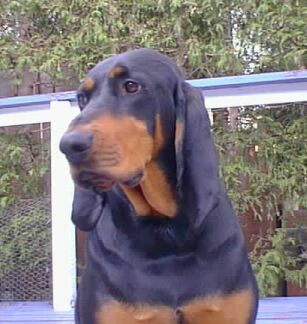Dog Day Saturday 2024-03-23
Owning and interacting with pets, according to studies, can be a form of therapy for many. We have dedicated Saturday to dogs and Wednesday to cats, when we will post an article on each of those days. We will also post articles on occasion about other animals people may have as pets. – Editorial Team
.
Black and Tan Coonhound
.

Scraig at the English Wikipedia, CC BY-SA 3.0, via Wikimedia Commons
The Black and Tan Coonhound is a distinctive American breed known for its hunting prowess, striking appearance, and gentle temperament.
History:
The Black and Tan Coonhound is one of the few breeds developed solely in the United States. Its roots trace back to colonial times when European settlers brought their hunting dogs to America. The breed was specifically bred for trailing and treeing raccoons and other small game, hence the name “Coonhound.” It was recognized by the American Kennel Club (AKC) in 1945.
Appearance:
- Size: Black and Tan Coonhounds are large and powerful dogs. Males typically stand between 25 to 27 inches tall at the shoulder, while females are slightly smaller, ranging from 23 to 25 inches.
- Weight: They weigh between 65 to 100 pounds, with males generally being heavier than females.
- Coat: The coat is short, dense, and glossy. The breed’s name refers to its distinctive black and tan coloration, with rich black being the primary color and tan markings on the muzzle, chest, legs, and underside.
- Ears and Tail: They have long, pendulous ears that hang close to the head and a long, tapering tail.
Temperament:
- Friendly and Outgoing: Black and Tan Coonhounds are known for their friendly and sociable nature. They typically get along well with children and other pets, including dogs, although early socialization is essential.
- Independent: Like many hounds, they can be independent-minded, which can sometimes translate into stubbornness. Consistent training from an early age is crucial.
- High Energy: These dogs are bred for endurance and stamina. They have a lot of energy and require regular exercise to stay mentally and physically healthy.
- Good-natured: Despite their hunting background, Black and Tan Coonhounds are usually gentle and affectionate with their families.
Exercise and Training:
- Exercise Needs: Black and Tan Coonhounds have high exercise requirements. They enjoy long walks, hikes, and opportunities to run and explore in a secure area.
- Training: Training should start early with positive reinforcement techniques. They respond well to firm, consistent, and patient training methods. Due to their strong prey drive, recall training and reliable off-leash control can be challenging.
- Mental Stimulation: They also need mental stimulation to prevent boredom, which can lead to destructive behaviors.
Health:
- Generally Healthy: Black and Tan Coonhounds are a relatively healthy breed overall, but like all breeds, they may be prone to certain health issues.
- Common Health Concerns: Some of the health issues that may affect this breed include hip dysplasia, ear infections (due to their pendulous ears), and bloat.
- Regular Vet Checkups: Regular veterinary checkups, a balanced diet, appropriate exercise, and maintaining a healthy weight are crucial for keeping Black and Tan Coonhounds in good health.
Grooming:
- Low Maintenance: Their short coat is relatively easy to care for and requires minimal grooming. Regular brushing to remove loose hair and occasional baths are usually sufficient to keep them looking their best.
- Ear Care: Due to their pendulous ears, regular ear cleaning is essential to prevent infections.
Living Arrangements:
- Living Space: While Black and Tan Coonhounds can adapt to apartment living with sufficient exercise, they are ideally suited to homes with large, securely fenced yards where they can roam and explore.
- Family Dogs: They thrive in homes where they are considered part of the family and included in daily activities.
Conclusion:
The Black and Tan Coonhound is a versatile and affectionate breed that excels as both a hunting companion and a family pet. With proper training, socialization, and exercise, they can make loyal and loving additions to households willing to meet their needs for physical and mental stimulation.

